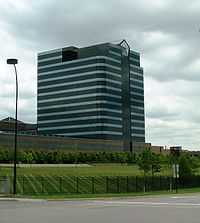Diamond-Star Motors
|
| |
| Type | Subsidiary |
|---|---|
| Industry | Automobile manufacturing |
| Founded | October 1985 |
| Headquarters | 100 N. Mitsubishi Motorway, Normal, Illinois 61761, United States |
| Key people |
Jerry Berwanger (EVP, COO) Hideyasu Tagaya (Chairman, MMNA) |
| Employees | 1,900 |
| Parent | Mitsubishi Motors North America |
| Website | MitsubishiManufacturing.com |
Diamond-Star Motors (commonly abbreviated to DSM) was an automobile-manufacturing joint venture between the Chrysler Corporation and Mitsubishi Motors Corporation (MMC).[1] The name came from the parent companies' respective logos: three diamonds (Mitsubishi) and a pentastar (Chrysler).[2] Diamond-Star Motors was officially renamed Mitsubishi Motor Manufacturing of America, Inc. (MMMA) in 1995, four years after Mitsubishi took sole control of the plant, and since 2002 its official title has been Mitsubishi Motors North America, Inc. (MMNA) Manufacturing Division.[3]
Three of the vehicles produced by Diamond-Star Motors, the Mitsubishi Eclipse, Eagle Talon, and Plymouth Laser, are also commonly referred to as "DSMs".[4]
Background
The origins of Diamond-Star Motors can be traced back to 1970 when Chrysler Corporation took a 15 percent stake in Mitsubishi Motors, as part of MMC's strategy of expansion through alliances with foreign partners. The U.S. company began distributing Mitsubishis as Chrysler-, Dodge- and Plymouth-branded captive imports (e.g. Dodge Colt), a successful venture as the compact cars met consumer demand for smaller and more fuel-efficient vehicles in the 1970s, filling a gap at the bottom of the Chrysler group's range.[5]
By 1982, Chrysler was importing 110,000 Mitsubishis annually. However, a minor conflict was forming as the Japanese now wanted to sell directly through their own-branded dealerships. A voluntary import quota system was in place at this time, restricting the number of cars Japanese automakers could bring into the U.S. As the Japanese company began to open its own branded dealerships to sell directly, every imported Cordia, Tredia and Starion sold by Mitsubishi had to be discounted from Chrysler's allocation.[5]
Incorporation


In order to circumvent this, the two partners officially incorporated Diamond-Star Motors in October 1985. An incentive package worth US$274 million, and an intense and controversial lobbying effort by state and local government authorities, meant that Illinois won the new auto plant,[6] and in April 1986 ground was broken on a 1,900,000 sq ft (180,000 m2) production facility in the town of Normal. The plant was completed in March 1988, with an annual capacity of 240,000 vehicles.[3] In 1989, the workers at the plant formed United Auto Workers Local 2488, and signed their first contract with the company.[7]
Initially, three models were produced at this facility. The Mitsubishi Eclipse, Plymouth Laser and Eagle Talon were smaller 2+2 sports cars on a new co-designed platform. Models subsequently produced during the next decade included the Mitsubishi Mirage/Eagle Summit sedans, the Mitsubishi Galant, the Dodge Avenger Coupe/Chrysler Sebring Coupe, and the Dodge Stratus Coupe.[8]
Departure of Chrysler
Initially Diamond-Star Motors was a 50-50 joint venture between Chrysler and Mitsubishi. However, in 1991 the Japanese company purchased its partner's equity stake, and thereafter the manufacture of Chrysler vehicles was on a contractual basis. Chrysler sold its equity stake to Mitsubishi in 1993, and Diamond-Star Motors was renamed to Mitsubishi Motors Manufacturing America (MMMA) on July 1, 1995.[3] Despite the departure, the two companies have maintained various co-operative manufacturing agreements since.
Formerly, the plant produced vehicles using the American-developed Mitsubishi PS platform, including the current Endeavor, Galant and Eclipse. In mid-2012, the plant began producing the Mitsubishi RVR platform sold in United States as the Outlander Sport. Approximately 1,900 people work in the highly mechanized plant, alongside approximately 1,000 robots. Expansion in 2003 means that it now occupies 2,400,000 sq ft (220,000 m2).[9]
Production
| Year | Vehicles |
|---|---|
| 1988 | 2,206 |
| 1989 | 90,609 |
| 1990 | 148,532 |
| 1991 | 153,526 |
| 1992 | 140,156 |
| 1993 | 135,610 |
| 1994 | 170,318 |
| 1995 | 218,507 |
| 1996 | 193,013 |
| 1997 | 189,023 |
| 1998 | 157,364 |
| 1999 | 162,199 |
| 2000 | 222,414 |
| 2001 | 193,780 |
| 2002 | 204,234 |
| 2003 | 173,872 |
| 2004 | 113,353 |
| 2005 | 87,791 |
| 2006 | 87,594 |
| 2007 | 78,771 |
| 2008 | 59,018 |
| 2009 | 18,502 |
| 2010 | 29,375 |
| Total to 2010 | 3,034,672[10] |
(source: MMNA Production History)
Club DSM - International Diamond Star Motors car club
References
- ↑ "Mixing Cultures On the Assembly Line", John Holusha, New York Times, June 5, 1988
- ↑ " Business People; Mitsubishi Executive Joins Chrysler Venture", John Holusha, New York Times, June 15, 1991
- ↑ 3.0 3.1 3.2 History of MMMA, MMMA official website
- ↑ "What exactly is a DSM?", DSM.org FAQ Page
- ↑ 5.0 5.1 History of Mitsubishi, Funding Universe
- ↑ Chapman, Margaret L.; Arun P. Elhance, John D. Wenum (1995). Mitsubishi Motors in Illinois. Greenwood Publishing Group. p. 129. ISBN 978-0-89930-972-9.
- ↑ "Working Class Voice: Labor Unions in McLean County", Chapter 20: UAW 2488, Bloomington & Normal Trades & Labor Assembly web site
- ↑ About the vehicles, MMMA official website
- ↑ About the facility, MMMA official website
- ↑ "Mitsubishi Motors reaches milestone of 3 million vehicles assembled in U.S.", MMNA Press Release, October 29, 2009
External links
- Mitsubishi Motors North America, Inc. Manufacturing Division, official website
| |||||
| |||||||||||||||||||||||||||||||||||||||||||||||
